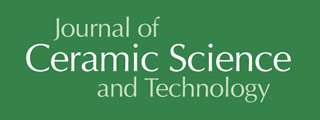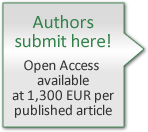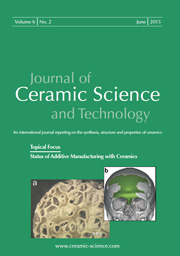Articles
All articles | Recent articles
Electrical and Dielectric Properties of Isostatically Pressed Alumina-Based Electroporcelain
V. Trnovcová1, M. Kubliha2, I. Štubňa1, Š. Csáki1,3
1 Department of Physics, Constantine the Philosopher University, A. Hlinku 1, SK-94974 Nitra, Slovakia
2 Institute of Materials, Faculty of Materials Science and Technology, Slovak University of Technology, J. Bottu 25, 917 24 Trnava, Slovakia
3 Charles University, Department of Physics of Materials, Ke Karlovu 5, 12116, Prague, Czech Republic
received November 15, 2017, received in revised form January 03, 2018, accepted February 07, 2018
Vol. 9, No. 2, Pages 149-154 DOI: 10.4416/JCST2017-00089
Abstract
The anisotropy of dc and ac conductivities and relative permittivity is studied in green, dehydroxylated, and fired, cold-isostatically pressed alumina-based electroporcelain. The dc conductivity, σdc, of green samples is isotropic and its temperature dependence contains two Arrhenius-like sections: below 140 °C, σdc = 5·10-2exp (-0.77/kT), and from 150 to 400 °C, σdc = 4·10-4exp (-0.56/kT), where σdc is in S/cm and conduction activation energies are in eV. The dc conductivity of dehydroxylated samples is also isotropic but much lower: below 200 °C, σdc = 1.7·10-3exp (-0.8/kT); above 210 °C, σdc = 0.7exp (-1.07/kT). Fired samples behave as fast-ionic conductors, above 300°C; temperature dependences of both dc and ac conductivities, in both directions, are given as σ = 17 exp (-0.785/kT). The anisotropy of the ac conductivity and permittivity is distinct only in as-received samples, being higher in the samples with a rotational axis in the direction of the blank radius. In green samples, anisotropy of the ac conductivity and permittivity is observed owing to relaxation of water molecules in closed pores and capillaries. The static relative permittivity of dehydroxylated and fired samples is equal to 6.3 ± 0.3 or 6.9 ± 0.1, respectively.
![]() Download Full Article (PDF)
Download Full Article (PDF)
Keywords
Electrical conductivity, dielectric properties, alumina-based electroporcelain, cold isostatic pressing
References
1 Hoffman, M., Danheim, H.: Development of technological texture in extruded ceramics, Keramische Zeitschrift, 39, 86 – 91, (1987).
2 Lučininova, N.I.: Investigation of texture of the ceramic blank by thermographic methods, Steklo i keramika, 12, 16 – 18, (1979)
3 Štubňa, I., Kalužná, M., Trnovcová, V.: Mapping the structure of electroporcelain blank by radiointroscopy, Ind. Ceram., 30, 17 – 20, (2010).
4 Boatner, L.A., Bolduo, J.L., Abraham, M.M.: Characterization of textured ceramics by electron paramagnetic resonance spectroscopy, J. Am. Ceram. Soc., 73, 2333 – 2335, (1990).
5 Kozík, T., Minárik, S.: New possibilities for investigation of the technological texture based on measurement of electric parameters: theoretical analysis and experimental verification, J. Electr. Eng., 64, 376 – 380, (2013).
6 Trnovcová, V., Furár, I., Hanic, F.: Influence of technological texture on electrical properties of industrial ceramics, J. Phys. Chem. Solids, 68, 1135 – 1139, (2007).
7 Štubňa, I., Valovič, Š.: Thermal expansion of textured electroceramics, Ind. Ceram., 24, 121 – 124, (2004).
8 Kalužná, M., Vozár, L., Gembarovič, J., Kaprálik,I.: The effect of texture on the thermal diffusivity of ceramic material, Ceram.-Silikáty, 36, 15 – 19, (1992).
9 Štubňa, I., Trnovcová, V.: The effect of texture on thermal expansion of extruded ceramics, Ceram.-Silikáty, 42, 21 – 24, (1998).
10 Štubňa, I., Lintnerová, A., Vozár, L.: Anisotropic mechanical properties of textured quartz porcelain, Ceram.-Silikáty, 52, 90 – 94 (2008).
11 Štubňa, I., Šín, P., Trník, A., Podoba, R., Vozár, L.: Development of Young's modulus of the green alumina porcelain raw mixture, J. Aust. Ceram. Soc. (in press)
12 Šín, P., Podoba, R., Štubňa, I., Trník, A.: Mechanical properties of alumina porcelain during heating, AIP Conf. Proc., 1634 – 76 – 80, (2014).
13 Lerdprom, W., Li, C., Jayaseelan, D.D., Skinner, S.J., Lee, W.E.: Temperature dependence of electrical conductivity of a green porcelain mixture, J. Eur. Ceram. Soc., 17, 343 – 349, (2017).
14 Lerdprom, W., Grasso, S., Jayaseelan, D.D., Reece, M.J., Lee, W.E.: Densification behavior and physico-mechanical properties of porcelains prepared using spark plasma sintering, Adv. Appl. Ceram., 116, 307 – 315, (2017).
15 Lee, S.J., Kim, Y.J., Moon, H.S.: Energy-filtering electron microscopy (EF-TEM) study of a modulated structure in metakaolinite represented by a 14 Å modulation, J. Am. Ceram. Soc., 86, 174 – 176, (2003).
16 Wang, X., Xiao, P.: Characterization of clay sintering process using impedance spectroscopy, J. Eur. Ceram. Soc., 22, 471 – 478, (2002).
17 Lee, V.G., Yeh, T.H.: Sintering effects on the development of mechanical properties of fired clay ceramics, Mater. Sci. Eng. A, 485, 5 – 13, (2008).
18 Sainz, M.A., Serrano, F.J., Amigo, J.M., Bastida, J., Caballero, A.: XRD microstructural analysis of mullites obtained from kaolinite-alumina mixtures, J. Eur. Ceram. Soc., 20, 403 – 412 (2000).
19 Chakraborty, A.K.: DTA study of preheated kaolinite in the mullite formation region, Thermochim. Acta, 398, 203 – 209, (2003).
20 Cheng, Y.F., Wang, M.Ch., Hong, M.H.: Phase transformation and growth of mullite in kaolin ceramics, J. Eur. Ceram. Soc., 24, 2389 – 2397, (2004).
21 Amigó, J.M., Serrano, F.J., Kojdecki, M.A., Bastida, J., Esteve, V., Reventós, M.M., Martí, F.: X-ray microstructure analysis of mullite, quartz and corundum in porcelain insulators, J. Eur. Ceram. Soc., 25, 1479 – 1486, (2005).
22 Kubliha, M., Trnovcová, V., Ondruška, J., Štubňa, I., Bošák, O., Kaljuvee, T.: Comparison of dehydration in kaolin and illite using DC conductivity measurements, Appl. Clay Sci., 149, 8 – 12, (2017).
23 Kubliha, M., Trnovcová, V., Ondruška, J., Štubňa, I., Bošák, O., Kaljuvee, T., Bačík, P.: DC conductivity of illitic clay after various firing, J. Therm. Anal. Calorim., 124, 81 – 86, (2016).
24 Podoba, R., Štubňa, I., Trnovcová, V., Trník, A.: Temperature dependence of DC electrical conductivity of kaolin, J. Therm. Anal. Calorim., 118, 597 – 601, (2014).
25 Hartmanová, M., Trnovcová, V.: Ionic crystals, Alfa, Bratislava 1972 (in Slovak).
26 Heide, K., Foldvari, M.: High-temperature mass spectrometric gas-release studies of kaolinite Al2[Si2O5(OH)4] decomposition, Thermochim. Acta, 446, 106 – 112, (2006).
27 Štubňa, I., Varga, G., Trník, A.: Investigation of kaolinite dehydroxylation is still interesting, Épitoanyag, 58, 6 – 9, (2006).
28 Trnovcová, V., Podoba, R., Štubňa, I.: dc conductivity of kaolin-based ceramics in the temperature range 20 – 600 °C, Építoanyag, 64, 46 – 49, (2012).
29 Štubňa, I., Kozík, T.: Electrical conductivity of kaolin in the temperature range 150 – 560 °C, J. Thermal Anal., 46, 607 – 610, (1996).
30 Kozík, T., Trnovcová, V., Mariani, E., Štubňa, I., Roháč, J.: The temperature dependence of the electrical conductivity of unfired porcelain mixture, Ceram.-Silikáty, 36, 69 – 72, (1992).
31 Trnovcová, V., Kozík, T., Mariani, E., Štubňa, I.: Relaxation of electrical properties of electroporcelain compacts over the temperature range 20 – 250 °C, Ceram.-Silikáty, 32, 233 – 240, (1988).
32 Ondruška, J., Štubňa, I., Trnovcová, V., Vozár, L., Bačík, P.: Polarization currents in illite at various temperatures, Appl. Clay Sci., 135, 414 – 417, (2017).
33 Ondruška, J., Štubňa, I., Trnovcová, V., Medveď, V., Kaljuvee, T.: Polarization and depolarization currents in kaolin, Appl. Clay Sci., 114, 157 – 160, (2015).
Copyright
Göller Verlag GmbH


